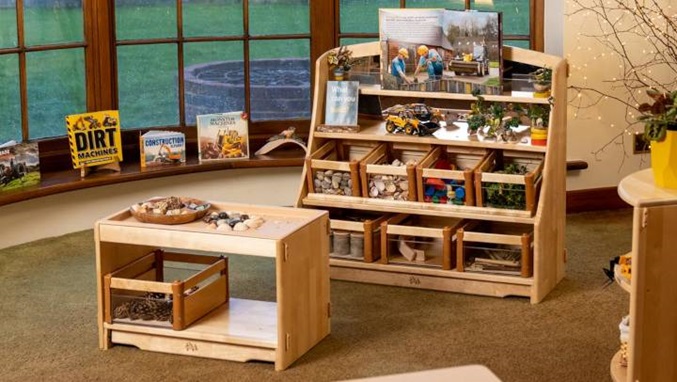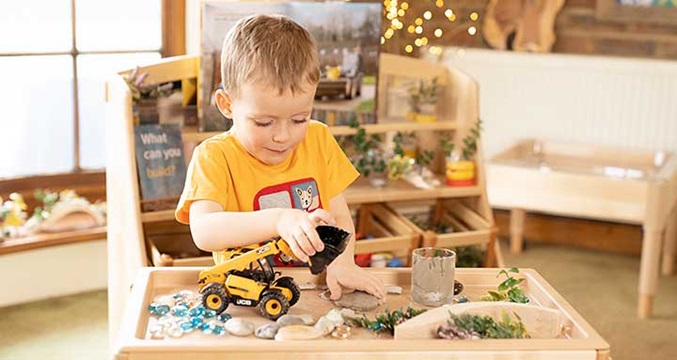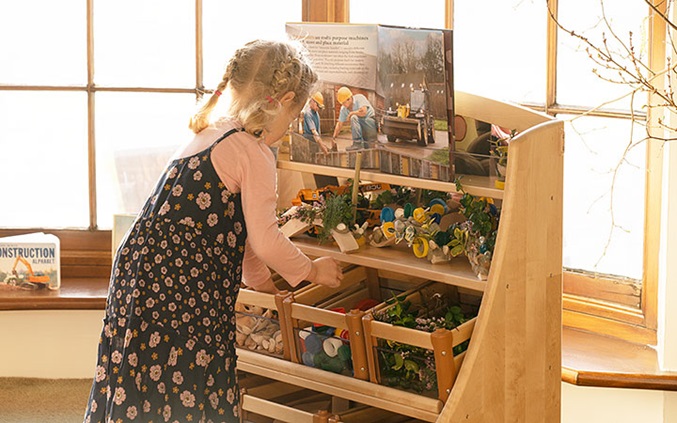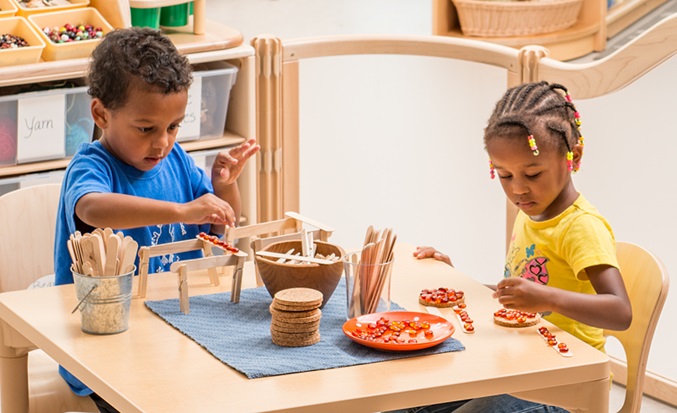Invitations and Provocations
Coming to terms with terms
| December 2022Recently, in a Facebook group, a poster asked for photos of provocations. Inspiring images were shared of arrangements on table tops and in large play trays. The common focus was the purposeful set-up of materials. The materials were chosen and displayed in aesthetically pleasing, photogenic ways to intentionally provoke curiosity.
The concept of using provocations in early education is not new. Materials have long been used to support learning – since the time of Froebel’s first Kindergarten. Materials shape the development of meaning between individuals, giving shared meaning to symbolic cognitive tools such as letters, numbers or words.
Materials are the text of early childhood classrooms. Unlike books filled with facts and printed with words, materials are more like outlines. They offer openings and pathways by and through which children may enter the world of knowledge. Materials become the tools with which children give form to and express their understanding of the world and the meanings they have constructed. – Harriet Cuffaro
Educators from Reggio Emilia speak of the hundred languages of materials that can develop over time when placed in the environment. Vygotsky suggested that the types of materials chosen facilitate the development of higher mental processes. How the materials are used, who is using them, where they are placed, and when they are offered – these are essential questions to ask. Most important, perhaps, is the question, “why these specific materials?”.

The problem with the beautiful “provocations” ubiquitously shared on social media is that we can't fully understand the context. What is being provoked? Children's interests, their agency, their thinking? Is the intention to deepen interest, increase agency and/or provoke thinking at higher levels? How engaged is an adult during the child's experiences with the provocation? I cannot know the motivation for what is shared on social media and labelled as provocations, but it appears to me that there is pride and pleasure derived from the presentation of an aesthetically pleasing and photogenic group of materials. The question I have is: who is the provocation for? If it doesn’t come from the children – their ideas, questions, thinking, theories and interests – where does it come from? Does it come from a desire to share one's creativity? Does it come from a desire to cover the curriculum and address outcomes?
Clearly, I am provoked as I ask these questions! I am provoked in a good way, as it is sparking professional inquiry. When you think about invitations and provocations, what do you think is most significant? What is the relationship between an invitation and provocation?
What is an Invitation?
An invitation is the act of inviting or presenting a situation that is tempting. I believe all we do with children should be invitational, supporting the premise that children learn through play. Play is freely chosen. When children have access to unstructured play that is truly child-led, they have control over the play activity. Children's sense of agency is fostered through self-directed play and it inspires rich learning. Agency is the ability to have choices and make decisions.
When an adult intentionally provides materials for children – set up to inspire learning – the child still must be allowed to follow their own ideas without adult-defined outcomes. If the child chooses to interact with the materials presented, the invitation is accepted. If this spark ignites engagement, then you have a provocation. If the invitation is ignored, it becomes an opportunity to reflect on why. Could it be that the children were just not interested? Was the invitation hidden away in a corner? What happens if children respond in a completely different way than expected? These questions should spark reflection and professional inquiry.

What is a Provocation?
An invitation that has been responded to is a provocation. A provocation is something that provokes action and stimulates thinking. Provocations are by nature nuanced and complex. They can be animate or inanimate. They can be concrete or abstract. Provocations can simply be a verbal exchange between the child and the educator who is the “provocateur”. The concept of provocations is not as simplistic as it is often pictured.
I wish I knew the full origin story of the term “provocation” in relation to early education. In my observation, it continues to be associated with the schools of Reggio Emilia. However, when I last visited a Reggio school in 2018, I was listening intently for the word “provocation” to no avail. I did hear the word “proposal” spoken of often. A proposal is an act of putting forward or stating something for consideration. In 1990, Rebecca New described the practice of inquiry in Reggio Emilia. She explained that children had many opportunities to create representations of their play and learning: “The results of children’s play and experimentation are represented by drawings. The teacher joins in by presenting the children with a challenge, or what is referred to as a provocation.”
We can see that a provocation is so much more than an Instagram-perfect photo. It is more than these beautiful, intentionally and purposefully concrete tabletop displays of materials with an accompanying book, or prompts such as “What do you see?” or “Can you make a pattern?”. The adult providing the “provocation” has something specific in mind to deliberately stretch the knowledge and experiences of the child.

Invitations in your Classroom
Placement
In 2007, Strong-Wilson and Ellis suggested introducing provocations such as “positioning small mirrors around the classroom or placing easels close to natural sunlight”, or placing “a pizza box in the kitchen corner, paper and pencil in the blocks area”. Other strategies suggested include bringing in realistic objects for children to use in their play such as real dishes or kitchen utensils. Provocations can be as simple as putting a mirror ball in the room to interact with the natural sunlight as a spark for discussion. The placement of the object is intentional to best capture the sun’s rays.
Storage
The way an object is stored can also be a provocation. Materials provided in transparent containers will piqué children’s curiosity and imagination. Containers with compartments such as muffin trays will provoke sorting by colour or texture. When the materials are easily accessible and visible, children may respond to materials in unexpected ways.

Time
Another important element of provocations is time. Are the invitational materials a one-day provision or are they left in the environment from week to week? How often are new provocations provided? If new provocations are provided each day, it is not really enough time for full engagement. Time is needed to experiment and express theories and ideas. Time is needed for documentation. Time is needed to more fully consider how to continue to provoke, arouse and stimulate.
Professional Development
I invite you to use both invitations and provocations as means to provoke your own professional learning. Start with an invitation to the children such as a display of materials grouped together purposefully with a written prompt, or an intentionally placed curiosity-triggering object. Observe and document how children respond to it. If the children respond it becomes a provocation. If there is a different response than expected or no response at all, it is an opportunity to be reflective. These, I believe, are the greatest benefits of invitations and provocations, however one defines the terms.

References
New, Rebecca S. 1989. Projects and Provocations: Preschool Curriculum Ideas from Reggio Emilia Italy. [Syracuse University]. Educational Resources Information Center (ERIC). https://files.eric.ed.gov/fulltext/ED318565.pdf
Strong-Wilson, Teresa and Julia Ellis. Children and Place: Reggio Emilia's Environment As Third Teacher. Theory Into Practice 46(1) pp 40-47 http://extendeddayresources.pbworks.com/w/file/fetch/110106670/Strong-Wilson%202007.pdf
Cuffaro, Harriet K. 1995. Experimenting with the World: John Dewey and the Early Childhood Classroom. Teachers College Press.







